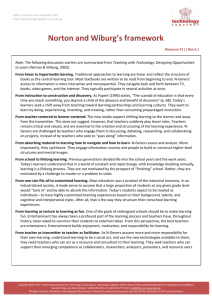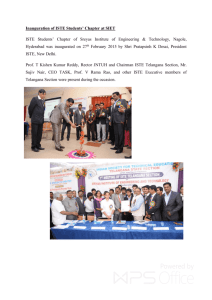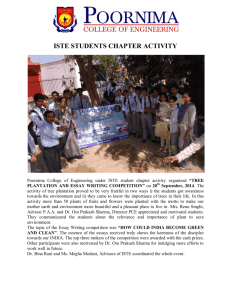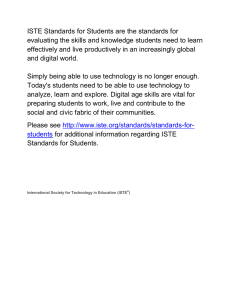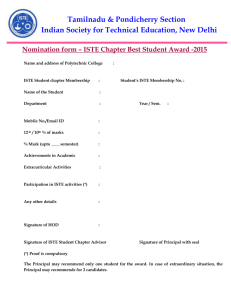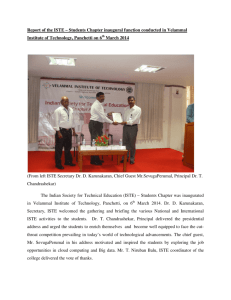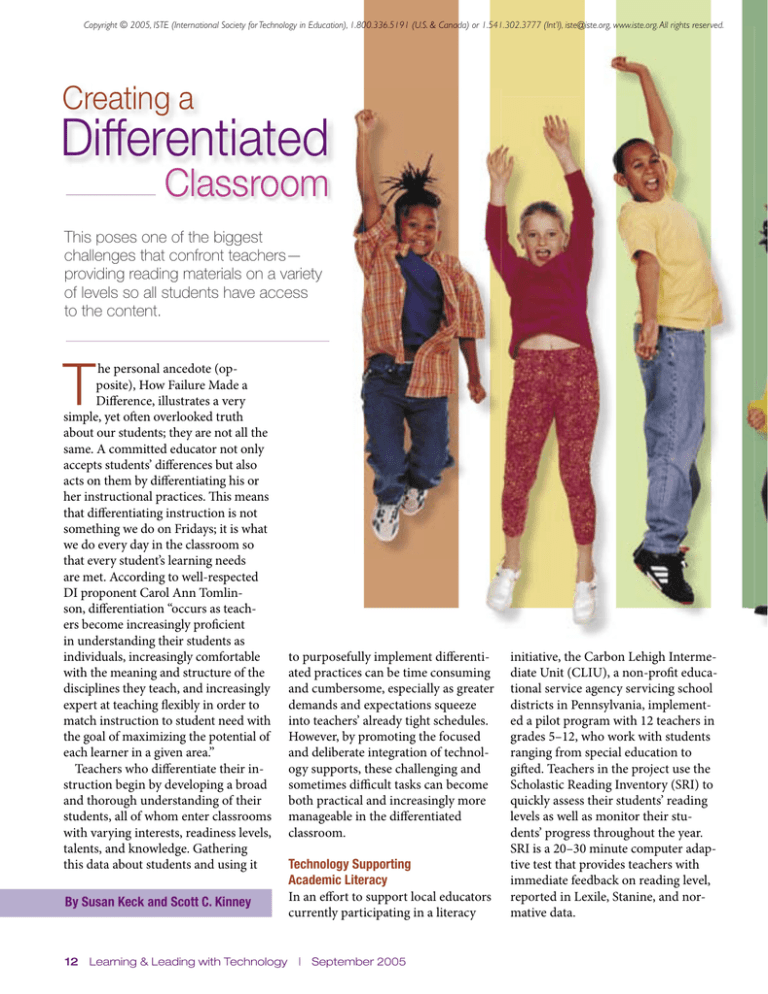
Copyright © 2005, ISTE (International Society for Technology in Education), 1.800.336.5191 (U.S. & Canada) or 1.541.302.3777 (Int’l), iste@iste.org, www.iste.org. All rights reserved.
Creating a
Differentiated
Classroom
This poses one of the biggest
challenges that confront teachers—
providing reading materials on a variety
of levels so all students have access
to the content.
T
he personal ancedote (opposite), How Failure Made a
Difference, illustrates a very
simple, yet often overlooked truth
about our students; they are not all the
same. A committed educator not only
accepts students’ differences but also
acts on them by differentiating his or
her instructional practices. This means
that differentiating instruction is not
something we do on Fridays; it is what
we do every day in the classroom so
that every student’s learning needs
are met. According to well-respected
DI proponent Carol Ann Tomlinson, differentiation “occurs as teachers become increasingly proficient
in understanding their students as
individuals, increasingly comfortable
with the meaning and structure of the
disciplines they teach, and increasingly
expert at teaching flexibly in order to
match instruction to student need with
the goal of maximizing the potential of
each learner in a given area.”
Teachers who differentiate their instruction begin by developing a broad
and thorough understanding of their
students, all of whom enter classrooms
with varying interests, readiness levels,
talents, and knowledge. Gathering
this data about students and using it
By Susan Keck and Scott C. Kinney
12 Learning & Leading with Technology
to purposefully implement differentiated practices can be time consuming
and cumbersome, especially as greater
demands and expectations squeeze
into teachers’ already tight schedules.
However, by promoting the focused
and deliberate integration of technology supports, these challenging and
sometimes difficult tasks can become
both practical and increasingly more
manageable in the differentiated
classroom.
Technology Supporting
Academic Literacy
In an effort to support local educators
currently participating in a literacy
|
September 2005
initiative, the Carbon Lehigh Intermediate Unit (CLIU), a non-profit educational service agency servicing school
districts in Pennsylvania, implemented a pilot program with 12 teachers in
grades 5–12, who work with students
ranging from special education to
gifted. Teachers in the project use the
Scholastic Reading Inventory (SRI) to
quickly assess their students’ reading
levels as well as monitor their students’ progress throughout the year.
SRI is a 20–30 minute computer adaptive test that provides teachers with
immediate feedback on reading level,
reported in Lexile, Stanine, and normative data.
Copyright © 2005, ISTE (International Society for Technology in Education), 1.800.336.5191 (U.S. & Canada) or 1.541.302.3777 (Int’l), iste@iste.org, www.iste.org. All rights reserved.
How Failure Made a Difference
I will never forget Tom. During my second year as a high
school English teacher, I vigilantly followed the curriculum and
assigned 20 SAT words each week, reviewed the definitions
on Thursday, and quizzed my students on Friday. In addition,
students wrote a paragraph using at least 10 of the words to
demonstrate an understanding of meaning in context. At that
time, I naively believed that to prepare my students for college,
we should focus on expository writing and the five-paragraph
essay, with little emphasis on creativity. As a result, the
paragraphs were usually dull, except Tom’s. I always looked
forward to reading his paragraphs because I was excited
to find out what happened next. Tom’s paragraphs were a
continuation of a story he started at the beginning of the
year about a battalion of Vietnam War soldiers. Every
Thursday Tom would say, “You’re going to love this one,
Mrs. Keck.” And I did.
At the end of the year, I reflected on my students and my
instruction and wrestled with the number of children in
my classes whose academic needs were minimally met.
I pondered about Alex and Sara, whose brilliant minds went
mostly unchallenged and about Beth, who approached writing
a coherent paragraph as a daunting task. And I thought a
great deal about Tom, who through his writing tried to tell me
all year he wanted to be successful. But I realized it too late.
How could I have allowed a creative thinker and writer like him
to consistently earn Cs and Ds in English?
I wrote Tom a letter that summer and thanked him for teaching
me a very valuable lesson. I learned that all students bring
a variety of talents to the learning process and that I need
to build upon those strengths rather than ignore them. Tom
helped me redefine my role as a teacher. He inspired me
to accept responsibility as an educator, embrace student
diversity, and push relentlessly to move each child toward
his or her academic potential. After that year, my classroom
looked very different.
Determining the Lexile level of
each student involved in the study
provides teachers with a baseline
and also with the evidence that not
all students in their classes read at
the same level. This poses one of the
biggest challenges that confront teachers—providing reading materials on
a variety of levels so all students have
access to the content. To address this
common situation, teachers involved
in the CLIU literacy project integrated
Achieve3000’s KidBiz/TeenBiz into
their curriculum. (Editor’s note: For
this and other URLs, see the Resources section on p. 15. Also see the review
of KidBiz on p. 40). KidBiz/TeenBiz
delivers text at appropriate grade levels to students. Partnered with Reuters
news service, KidBiz/TeenBiz identifies one or more current news events
and uses Lexile readability measurements to convert the text into multiple
articles at appropriate reading levels.
Based on each student’s profile, which
includes reading level, second language attributes, and auditory needs,
students are delivered appropriate
reading materials, activities, assessments, and supports. Students are
empowered, regardless of reading
level or language mastery, to discuss
common themes and contribute in
shared discussions.
September 2005
|
A typical heterogeneously grouped classroom consists of numerous
students with a wide range of reading abilities. Cognitive abilities also
vary greatly and are often inaccurately correlated to a student’s reading
level. A child may not be reading at
grade level, but that does not mean
that child is not capable of working
or thinking at grade level or above.
For example, Eduardo’s first language
is Spanish, in which he can speak,
read, and write fluently. Although
Eduardo is not fluent in English,
this is not a determining factor in
his ability to master higher-level
thinking.
Learning & Leading with Technology 13
Copyright © 2005, ISTE (International Society for Technology in Education), 1.800.336.5191 (U.S. & Canada) or 1.541.302.3777 (Int’l), iste@iste.org, www.iste.org. All rights reserved.
Students log in to their KidBiz/
TeenBiz account and are greeted by
an age-appropriate Web portal. Once
logged in, students receive an e-mail
message previewing that day’s article.
Students are prompted to respond,
which supports the building of background knowledge and opportunities
for students to make personal connections, both of which play an integral
role in overall reading comprehension.
What students already know about
the content is one of the strongest
indicators of how well they will learn
new information relative to the content. Once students build background
knowledge, they are guided to read
that day’s article, which is provided to
each student at the appropriate reading level. Articles are interlaced with
highlighted vocabulary words, also
appropriate for each student based on
his or her profile. After completion of
the reading assignment, students are
asked to engage in an assessment activity that includes questions aligned
to various levels of Bloom’s taxonomy.
Delivering materials that enable
all students to access the curriculum
at their appropriate level is not only
a tenet of DI, but also difficult to
facilitate using traditional methods.
This process, however, can become
manageable through the effective
and purposeful use of technologies
such as KidBiz3000 and TeenBiz3000.
Students are empowered when they
can simultaneously work on and have
meaningful conversations about the
same content as their classmates. They
are further empowered when they can
access those materials and contribute
in the larger learning community of
the classroom.
Supporting the Writing Process
The National Committee on Writing in its 2003 report The Neglected
“R”: The Need for a Writing Revolution, states, “Writing today is not a
frill for the few, but an essential skill
for the many.” The report continues,
14 Learning & Leading with Technology
What students already know about the content is one
of the strongest indicators of how well they will learn
new information relative to the content.
“Although many models of effective
ways to teach writing exist, both the
teaching and practice of writing are
increasingly shortchanged throughout
the school and college years. Writing,
always time consuming for student
and teacher, is today hard-pressed
in the American classroom. Of the
three ‘Rs,’ writing is clearly the most
neglected.” Unfortunately, a typical
teacher of writing may see between
120–200 students each day. A teacher
assigning a simple three-page essay
has also just assigned him- or herself
hundreds of papers to assess and provide feedback, nearly impossible to do
in a timely manner.
Another technology-based literacy
tool, MY Access!, enables teachers to
take this nearly unmanageable process, automate it, and promote what
we know about how students learn by
allowing repetition and providing immediate feedback. Students using MY
Access! are delivered a writing prompt
through an online Web portal. Students write to the prompt using a variety of tools integrated into the system.
Classroom teachers have the ability to
scaffold support as they see appropriate. Students needing additional support may have access to writing tools
such as graphic organizers, checklists,
and feedback mechanisms. Teachers
have the ability to remove these additional supports for the more advanced
writers.
Once students complete their writing assignment, they can electronically submit their essay for scoring. MY
Access! uses an artificial intelligence
scoring engine to score both holistically and by domain. Students’ scores
are immediately reported. This immediate feedback is important because of
|
September 2005
not only its high motivational effect,
but also its instructional benefit.
To differentiate, teachers can choose
to assign prompts in a variety of ways.
For example, in a typical classroom,
students’ writing skills are at numerous levels. Therefore, the classroom
teacher may choose to have several
groups and assign struggling writers
prompts appropriate for their writing
level and scored accordingly. Students
working above grade level may be
assigned prompts that are more stringently graded. Additionally, because
teachers are provided a plethora of reports, instructors can pinpoint student
weaknesses and provide them with
practice most applicable to them. For
example, if a teacher knows that four
students consistently score low in the
domain of organization, he or she can
limit MY Access! to provide feedback
to those students only in that specific
domain.
Providing both immediate feedback
and the opportunity for unlimited
revisions, MY Access! eliminates several of the issues teachers encounter
when assigning writing. According to
the publisher of MY Access!, a series
of case studies support the use of this
technology to increase student performance. A study in Birmingham
High School, part of the Los Angeles
Unified School District, showed,
“School-wide, 81% of Birmingham
students who used MY Access! passed
the California High School Exit Examination, while only 46% of the
students who did not use MY Access!
passed the exam.” In Pennsylvania’s
Parkland School District, “Using MY
Access!, 91% of 709 students tested
on the Pennsylvania System of School
Assessment in 2003 attained scores of
Copyright © 2005, ISTE (International Society for Technology in Education), 1.800.336.5191 (U.S. & Canada) or 1.541.302.3777 (Int’l), iste@iste.org, www.iste.org. All rights reserved.
Proficient and Advanced, compared
to only 76% of 711 students tested in
2000 who did not use MY Access!”
Allowing repetition and providing
immediate feedback during instruction are essential to develop the skills
inherent to good writing. Many teachers find both of these attributes to be
challenging, if not impossible at times.
However, through the strategic intervention of technology, MY Access!
can provide teachers a powerful tool
to assist in this developmental process.
Motivating and Engaging
Students through Video
The incorporation of rich media into
any curricular area can significantly
enhance instruction, providing another means of access to content supporting the visual and auditory modes
of learning. Unitedstreaming, a videoon-demand library of more than 4,000
full-length video titles and 40,000
clips, provides teachers with instantaneous access to state standard-aligned
media. Streamed through the Internet
directly to a teacher’s personal computer, unitedstreaming provides engaging media to support the classroom
curriculum. Additionally, individual
access allows students to explore key
concepts at their own pace or according to their personal interest.
Diverse classrooms pose many
challenges and require teachers to
develop a variety of activities to help
students understand key concepts and
make connections to their learning.
For example, Mr. Prange teaches high
school geometry. He often finds that
some students enter a unit ready for
more complex learning, some are on
level, and others need multiple and
varied learning experiences. Recently,
when teaching the concept of area, Mr.
Prange found that by integrating unitedstreaming to support key concepts,
he opened the door of understanding
for those students who required visual
supports and additional explanations
beyond textbook materials and lecture.
Mr. Prange also acknowledged the
need for students who already mastered the basic concepts of area to further their investigation through selfdirected exploration of incrementally
more complex concepts. Providing
opportunities for students to accelerate their learning through both selfand teacher-selected investigations,
Mr. Prange ensured these students
access to content that ignited their interest and increased their engagement.
In technical terms, unitedstreaming
is one example of a technology that
assists teachers in differentiating content, process, and product. For example, allowing students to choose topics
to explore differentiates the content or
the “what” we want students to learn.
Providing that content in various formats, such as video, allows students
to master content through a process
most meaningful for them.
Bringing It All Together
Perhaps if Tom’s interests and
strengths were honored as a critical
component of his learning experience,
rather than giving precedence to curriculum coverage, his junior year of
English may have ended much differently. Differentiation means ensuring
equity in the learning process. We do
this by finding ways to breathe life
into the curriculum so that students
connect with their learning and develop the best that is in them.
However, differentiating instruction on a daily basis is a difficult task.
Imagine a single teacher attempting to
This immediate feedback is important because
of not only its high motivational effect, but also
its instructional benefit.
September 2005
|
level the same newspaper article every
day for each student in the classroom.
Picture that same teacher monitoring
as many as 150 students so closely that
minor progress changes immediately
result in appropriate adjustments in
student reading levels. Imagine a writing teacher being able to assign essays
as often as desired while still providing immediate diagnostic feedback.
Furthermore, envision that teacher
with the ability to instantaneously
produce reports on student writing
either individually or by class. Although these tasks may seem outside
the realm of possibility for most
teachers, by strategically implementing technology in support of teaching
and learning, educators can provide
students with multiple paths to academic success. Discuss this article
with the authors and weigh in on other educational issues by visiting http://
discoveryeducation.typepad.com/.
Resources
KidBiz/TeenBiz: http://www.achieve3000.com
MY Access!: http://www.gomyaccess.com
Susan Keck has more than
15 years of educational experience. Prior to joining the Carbon Lehigh Intermediate Unit,
Susan coordinated professional
development programs and
trainings for the Penn State
Lehigh Valley Writing Project, earning her
Writing Project Fellow status in 2000. Susan
continues to develop, coordinate, and present
various training sessions. Currently, she leads
numerous local initiatives including Adolescent
Literacy, Literacy Leadership, and Teacher
Leadership.
Scott C. Kinney has more
than a decade of experience
integrating technology into
the educational setting.
Before becoming the director
of educational technologies at
the Carbon Lehigh Intermediate Unit, Scott served as the assistant director
of curriculum and instruction & instructional
media services. Scott continues to work with
educators across the country examining ways
technology can support curricular initiatives
and instructional practices.
Learning & Leading with Technology 15

